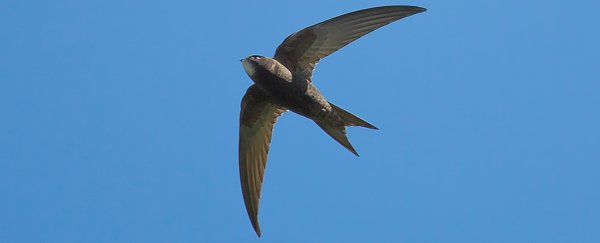Thanks to the development of miniature electronic tags, researchers have discovered that the common swift is able to stay in the air for 10 months straight without touching the ground – and that's a record for natural sustained flight.
Scientists have long suspected that swifts spend a long time in the air, but we now have proof, thanks to the data logging tech fitted to a group of 13 swifts. Their movements were monitored over the course of two years.
Three of the birds didn't touch down for 10 months, according to the team at Lund University in Sweden. They take a rest for two months to enjoy breeding season, and then it's back up into the air again.
"This discovery significantly pushes the boundaries for what we know about animal physiology," said one of the research team, Anders Hedenström. "A 10-month flight phase is the longest we know of any bird species – it's a record."
The tiny, lightweight gadgets fitted to the backs of the swifts were able to report back whether or not the birds were in the air, how fast they were accelerating, and their current location. Even the birds that did take a quick vacation on the ground stayed in the air for 99.5 percent of their migration period.
The backpacks the team used weighed less than 1 gram (3.5 hundredths of an ounce) and have light sensors fitted to them. By matching sunrise and sunset times with the logged light, the researchers can work out where the birds have been.
The team also found that the birds that stayed aloft for almost the whole year had moulted and gained new wing and tail flight feathers while in the air. Those that had landed at some point hadn't moulted, and the researchers think that could explain differences in flight behaviour and their general condition.
The common swifts have smashed the previous flight record held by their close relatives the alpine swifts, which are known to be able to manage six months of continuous flight. These birds can travel millions of miles during their lifetimes, which average out at about 5.5 years, moving between Europe and Africa with the seasons.
Now Hedenström and his team have identified how long these birds can stay in the air, the next question is: how do they do it? It takes plenty of energy to stay up in the air and there's also the issue of how the birds sleep – if they actually need sleep.
"They might do as the frigate bird [does] and sleep while gliding," explained Hedenström. "Every day, at dusk and dawn, the common swift rises up to an altitude of about 2-3 kilometres. Perhaps they sleep during a declining glide, but we're not sure."
The results of the study have been published in Current Biology.
Check out the video below to see the swifts in action:

